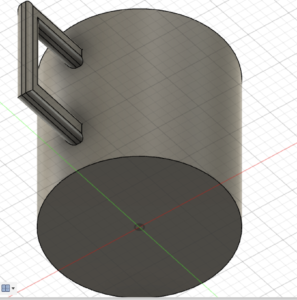


How easy/hard was it?
It was easy to start modeling and create the main cylinder shape from which the body of the mug was derived. I sketched a circle and extruded it up to create the cylinder. I then made another circle and extruded it down so it cut out the majority of the mug, leaving just the bottom and the main space in the middle of the cup portion. It was very easy to get on the right track with this project, especially since I chose a simpler design for the mug.
What elements particularly bogged you down?
I got stuck on the handle for quite a long time, mainly because I was debating which method to use: create an ellipse and extrude it, or extrude from a curve or mesh. I decided to do something entirely different, which was sketch a rectangle from a side plane view, and then draw another rectangle inside the first and then extrude that backwards through the outer rectangle, creating a hole and a square handle. I then used the fillet tool to bevel some edges, yet I could not figure out how to bevel all the edges, since I used the online client and the program proved to be quite laggy at that point.
What compromises did you have to make?
I had to leave sharp corners on the handle, and I didn’t get to materials and texturing. If I had used Blender, which is a program I feel much more comfortable with, I feel like I could have gotten a much more polished final product. I will continue to learn the keyboard shortcuts for Fusion360 in hopes that I will get more comfortable with using this program, but for now, I will try my best to model these objects in their entirety.
What humanistic uses can you envision for this tool in the areas of research or teaching?
I can definitely see this tool being used to experiment with the idea of collision in higher-dimensional spaces, such as a 4D video game. As I was reading through the tool notes and documentation, I realized that Fusion360 can model sheet metal and many other substances as well as collisions. Rendering objects in higher dimensions, maybe with a handwritten engine, seems very interesting as some programmers are making higher-dimensional programs and games recently.
P.S. – holes are very useful to make empty space if you use them correctly! There’s also an alternative which involves extruding the opposite way (backwards) from a sketch which is drawn on a plane or mesh.
1 thought on “3D Modeling my Camping Mug”
Comments are closed.

I also had difficult with materials and texturing, thanks for the tip with using holes to make empty space!